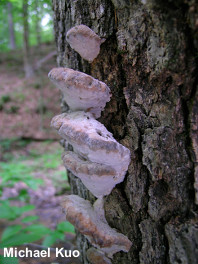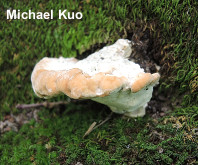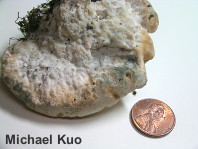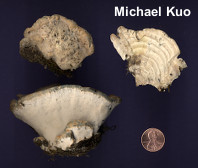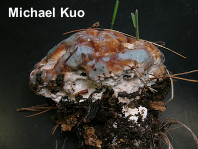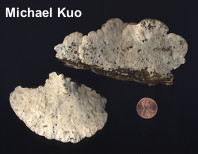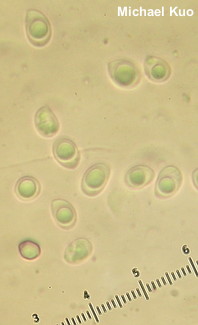| Major Groups > Polypores > Fomitopsis spraguei |

|
Fomitopsis spraguei [ Basidiomycota > Polyporales > Fomitopsidaceae > Fomitopsis . . . ] by Michael Kuo When young and fresh, Fomitopsis spraguei is a small, distinctive polypore from eastern North America's oak-based hardwood forests. It features a lumpy, whitish to grayish cap with an orangish edge that stains grayish green, along with a similarly staining pore surface—and, when sliced and exposed, the fresh flesh is distinctively zoned with layers of whitish and grayish. Fomitopsis spraguei is annual, but it hangs around for a long time, which means that one often finds it in its not-so-fresh state, when the green staining no longer occurs and the flesh is less clearly zoned. At this point the species is much more difficult to identify with certainty, and one must rely on the fact that it causes a brown, cubical rot (rather than a white, stringy rot)—and on microscopic features, including its broadly ellipsoid spores and trimitic hyphal system. Readers who are polypore buffs and own the North American "polypore bible" (Gilbertson & Ryvarden, 1986 & 1987) may notice that green staining and zonate flesh are not mentioned for Fomitopsis spraguei. However, both Murrill (1907) and Overholts (1953) document these features. Polyporus spraguei, Trametes spraguei, and Tyromyces spraguei are previous names. Description: Ecology: Saprobic on the dead and living wood of oaks and other hardwoods; also possibly parasitic on living trees; causing a brown cubical rot; growing alone or gregariously; annual; spring through fall; widely distributed in North America east of the Rocky Mountains. The illustrated and described collections are from Illinois and Ohio. Cap: 2–10 cm across; up to 6 cm deep; semicircular to nearly circular or irregular in outline; planoconvex to flat or shallowly depressed; rugged and pocked; very finely fuzzy toward the margin when young, becoming finely fuzzy overall; dry, or, when very fresh, sometimes exuding clear droplets of liquid; grayish overall, becoming whitish; fresh margin brownish orange; when young and fresh bruising grayish green, especially near the margin. Pore Surface: Grayish white; bruising grayish green when fresh, but bruising brownish at maturity; 1–3 angular pores per mm; tubes 2-4 mm deep. Stem: Usually absent, but occasionally present as a stubby, lateral extension; 1–2 cm long; 1–2 cm thick; whitish to brownish; fuzzy. Flesh: Whitish to watery gray or slightly bluish; when fresh and young clearly divided into zones of whitish and grayish; unchanging when sliced; soft-leathery, becoming tougher with age. Odor and Taste: Odor fragrant; taste not distinctive. Chemical Reactions: KOH negative on flesh; yellowish on cap surface and pore surface. Microscopic Features: Spores 5–8 x 4–5 µm; ellipsoid; smooth; hyaline in KOH; inamyloid. Hyphal system trimitic: generative hyphae 2–4 µm wide, thin-walled, clamped, smooth; skeletal hyphae 4–6 µm wide, thick-walled, smooth; binding hyphae 2–4 µm wide, thick-walled, non-septate. REFERENCES: (Berkeley & M. A. Curtis, 1872) Gilbertson & Ryvarden, 1985. (Saccardo, 1888; Murrill, 1907; Overholts, 1953; Gilbertson & Ryvarden, 1986; McNeil, 2006; Binion et al., 2008.) Herb. Kuo 07120303, 08200501, 06071004, 07171004, 07081104, 09171401, 07111601. This site contains no information about the edibility or toxicity of mushrooms. |
© MushroomExpert.Com |
|
Cite this page as: Kuo, M. (2016, August). Fomitopsis spraguei. Retrieved from the MushroomExpert.Com Web site: http://www.mushroomexpert.com/fomitopsis_spraguei.html |
